For most organizations, it’s useful to create a graphical representation of the hierarchy of the organization. It helps employees get a clear understanding of where they sit within the company. Apart from that, an organization chart is a valuable tool that serves many other purposes, which we will discuss later in this article. Several organizational chart types are available, depending on the nature of the organization.
Through this article, you will gain a thorough understanding of organizational charts, including the types of charts, their use cases and limitations.
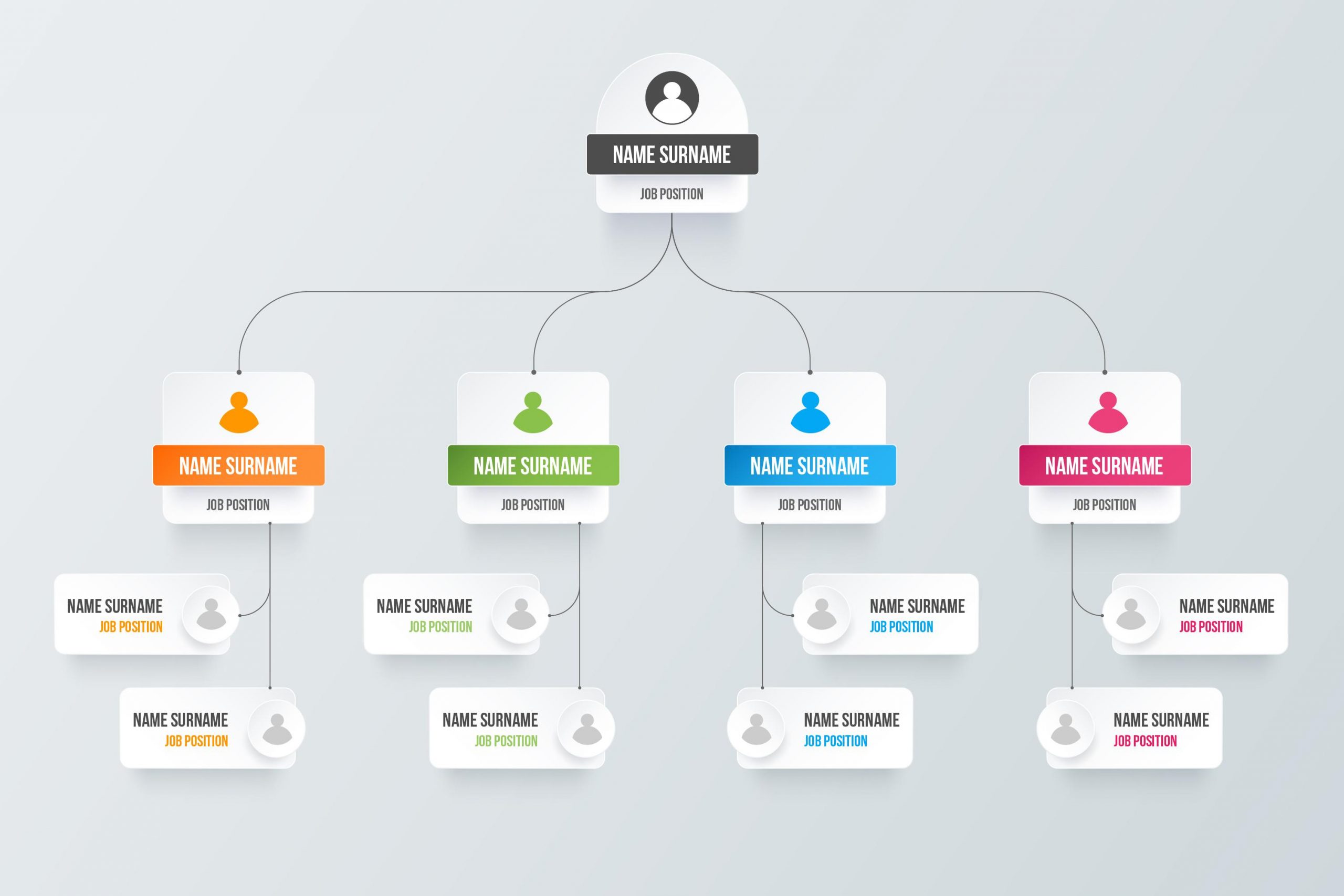 As mentioned earlier, this is the most common organizational structure, arranged in a pyramid shape. The top level employees like the CEO are on top while the low-level or entry level employees remain at the bottom. The command chain flows from top to bottom. We can gain a clear understanding of the level of authority and responsibility by looking at this type of chart. Moreover, hierarchical organizational structure offers a specialty to each employee and shows to whom each employee should report to.
As mentioned earlier, this is the most common organizational structure, arranged in a pyramid shape. The top level employees like the CEO are on top while the low-level or entry level employees remain at the bottom. The command chain flows from top to bottom. We can gain a clear understanding of the level of authority and responsibility by looking at this type of chart. Moreover, hierarchical organizational structure offers a specialty to each employee and shows to whom each employee should report to.
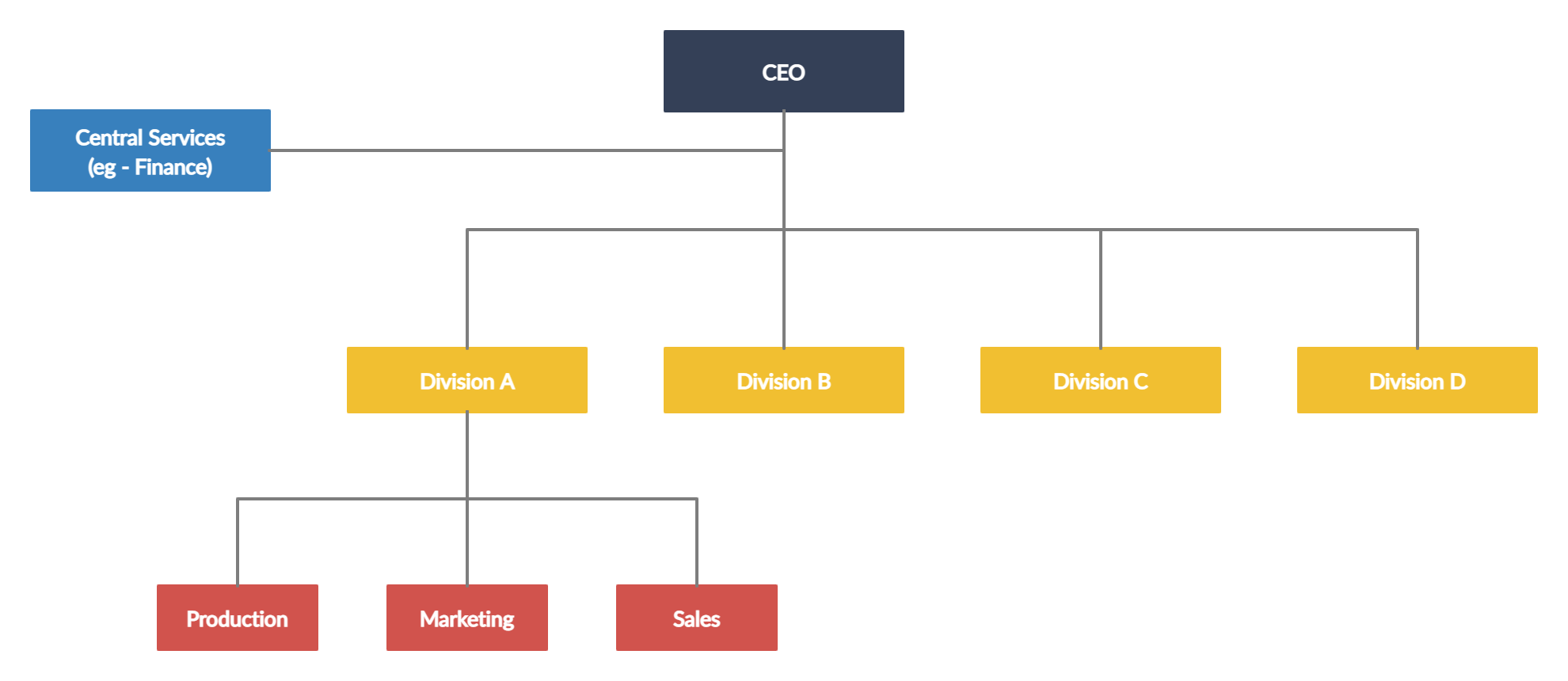 A divisional organizational structure allows each division to manage its own resources. Thus, those divisions can function independently as separate companies under the main organization. Each division can maintain their own marketing team, sales team or IT team.
This structure is well-suited for large organizations as it allows those departments to make decisions without always depending on the top management.
A divisional organizational structure allows each division to manage its own resources. Thus, those divisions can function independently as separate companies under the main organization. Each division can maintain their own marketing team, sales team or IT team.
This structure is well-suited for large organizations as it allows those departments to make decisions without always depending on the top management.
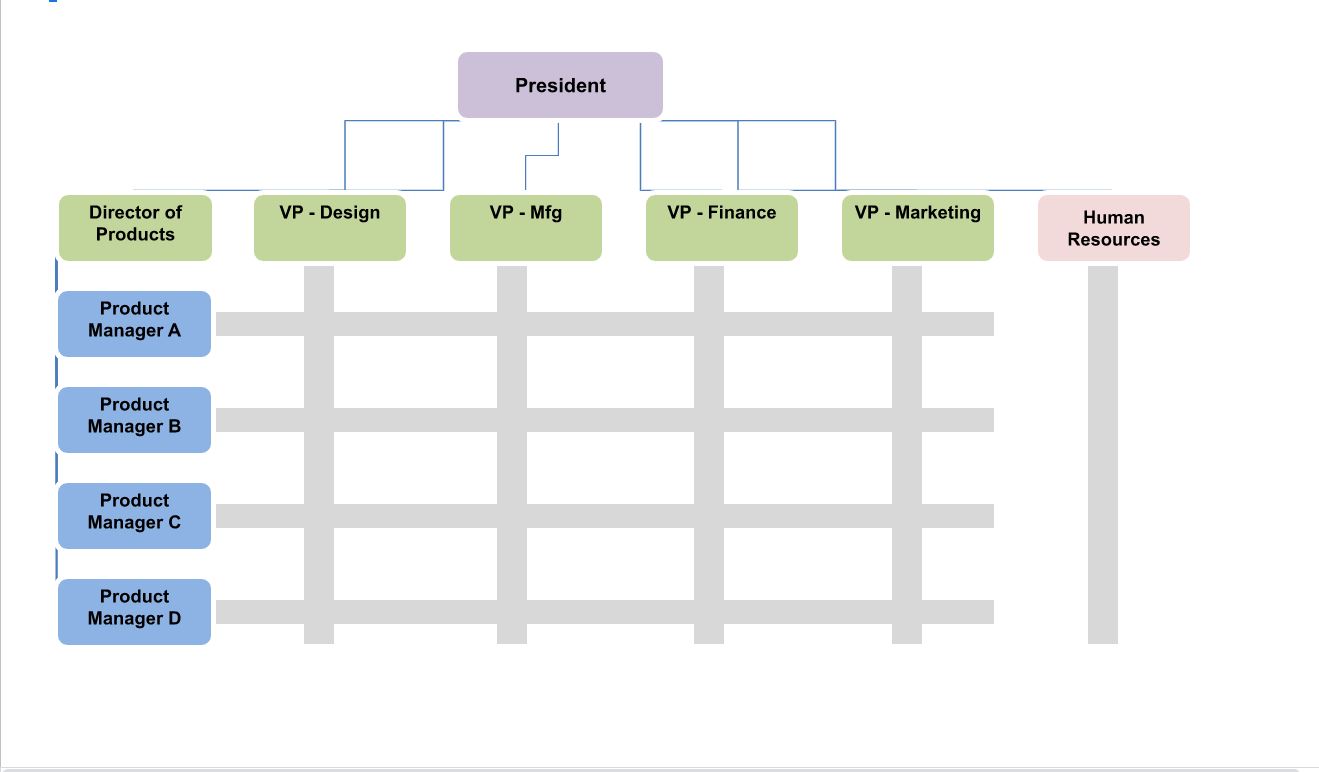 The matrix organizational chart is one of the popular organizational chart types that looks like a grid, deviating from the traditional hierarchy and providing a more dynamic view of the organization. The special thing about these charts is that they depict the multi-functional teams that work on specific projects. While each team will have a project manager, the employees will also report to a functional manager.
For instance, an engineer will always work under the engineering department managed by the engineering manager. Yet, sometimes he might be assigned to a certain project led by a project manager. So he will have to report to multiple managers at the same time.
This way, matrix organizational charts highlight both the vertical as well as the horizontal communication flow in an organization. This structure creates a more dynamic and flexible work environment by breaking down the vertical silos. It allows shifting resources to positions they are needed and encourages more open communication.
The matrix organizational chart is one of the popular organizational chart types that looks like a grid, deviating from the traditional hierarchy and providing a more dynamic view of the organization. The special thing about these charts is that they depict the multi-functional teams that work on specific projects. While each team will have a project manager, the employees will also report to a functional manager.
For instance, an engineer will always work under the engineering department managed by the engineering manager. Yet, sometimes he might be assigned to a certain project led by a project manager. So he will have to report to multiple managers at the same time.
This way, matrix organizational charts highlight both the vertical as well as the horizontal communication flow in an organization. This structure creates a more dynamic and flexible work environment by breaking down the vertical silos. It allows shifting resources to positions they are needed and encourages more open communication.
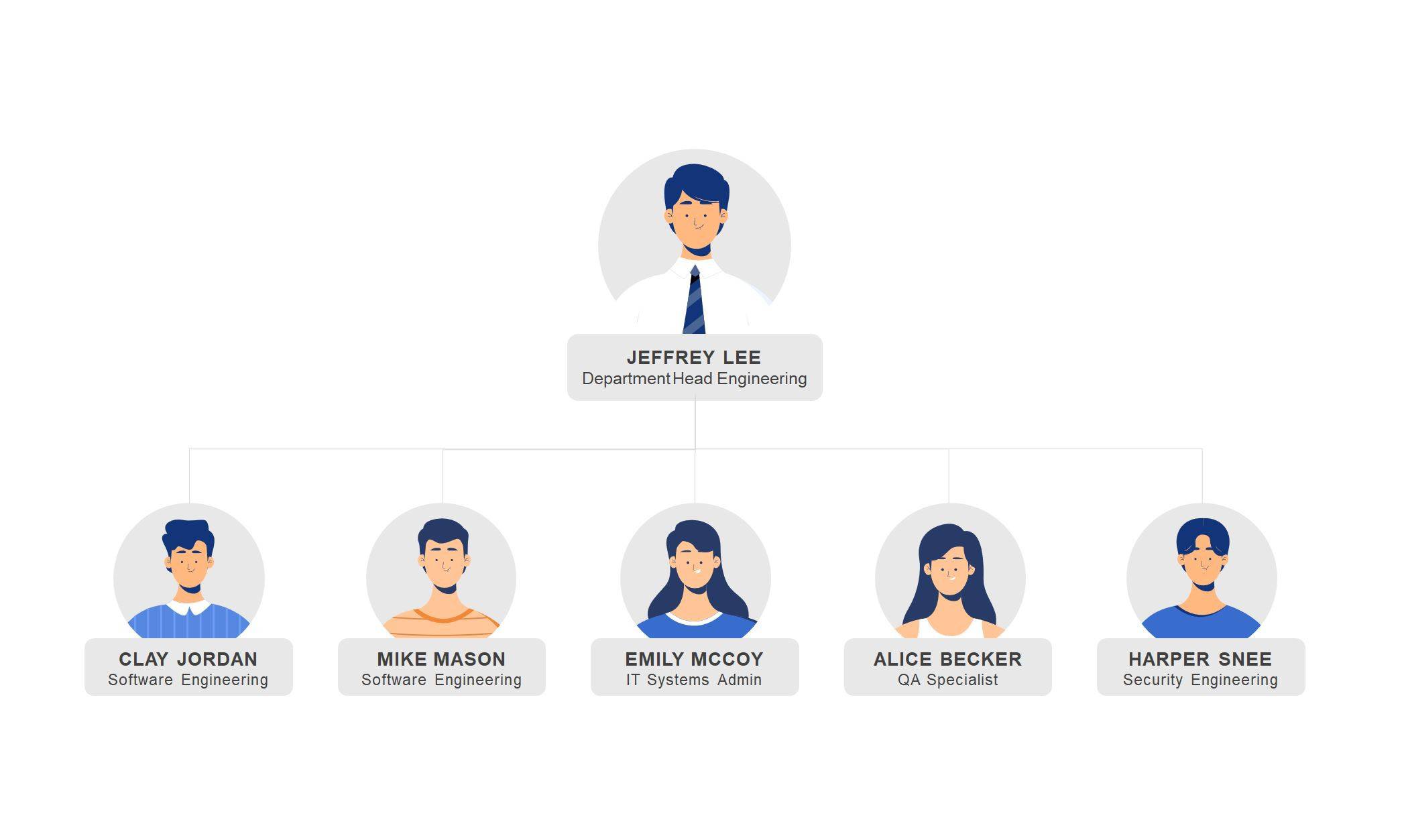 The flat org chart, which is also known as the horizontal org chart, are well-suited for organizations with fewer levels between the senior management and staff. This kind of structure offers a great decision making power for each employee and allows implementing new ideas faster. It also empowers employees for self management without much supervision.
This type of structure eliminates the need for middle management levels. Many small or start-up companies tend to use this organizational structure until they expand enough to divide into different departments. However, some organizations have adopted a flat organizational structure as it brings up more involvement and open communication between employees at various levels.
The flat org chart, which is also known as the horizontal org chart, are well-suited for organizations with fewer levels between the senior management and staff. This kind of structure offers a great decision making power for each employee and allows implementing new ideas faster. It also empowers employees for self management without much supervision.
This type of structure eliminates the need for middle management levels. Many small or start-up companies tend to use this organizational structure until they expand enough to divide into different departments. However, some organizations have adopted a flat organizational structure as it brings up more involvement and open communication between employees at various levels.
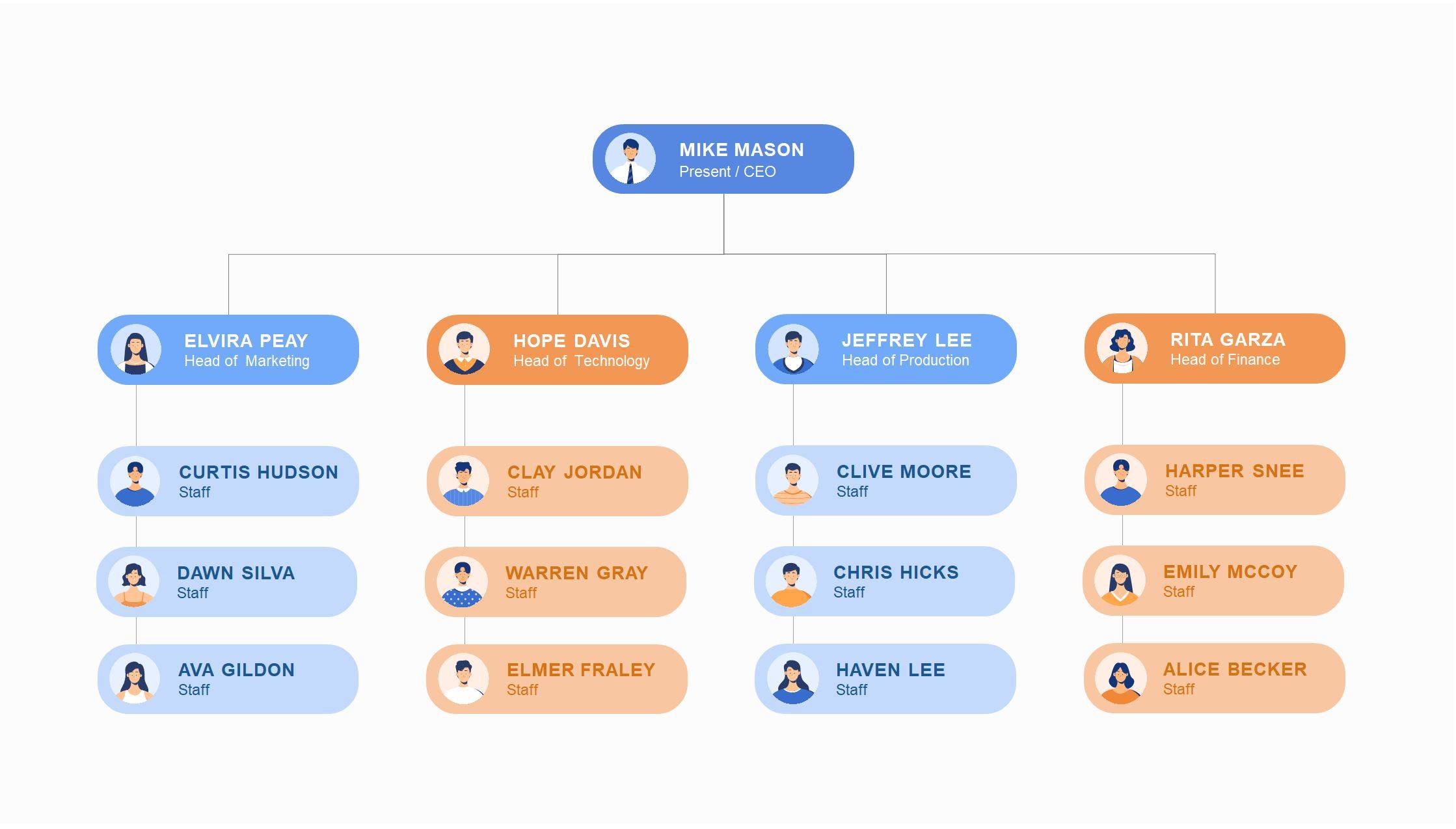 A functional organizational chart represents the top-down structure of a company, dividing it into various departments. This type of org charts groups employees with similar skills under a single unit. For instance, there can be marketing, sales, finance, HR, and IT departments.
Each unit will have a department head. All these department heads will report to a common manager who will integrate the functionality of all these departments.
A functional organizational chart represents the top-down structure of a company, dividing it into various departments. This type of org charts groups employees with similar skills under a single unit. For instance, there can be marketing, sales, finance, HR, and IT departments.
Each unit will have a department head. All these department heads will report to a common manager who will integrate the functionality of all these departments.
Table of Contents
What Is An Organizational Chart?
An organization chart is a visual representation of the internal structure of a company in the form of a diagram. This diagram showcases employees and their positions using boxes or other shapes. It can also include images of employees, their contact information, emails, and web page links. Some charts use symbols or other illustrations to represent employees and their roles. Employee levels are linked using straight or elbowed lines. Org charts can be drawn for various purposes and structured in different ways. One major purpose of an organizational chart is to showcase the reporting relationships and the flow of command within the company. It can also be used for planning purposes or as a personnel directory. When talking about the structure of organization charts, the most common structure is the hierarchical model. It displays the employees of management and other high-level positions on top while showing the low-level employees at the bottom. A glance at the org chart will give anyone a better understanding of the layout of the organization, including the number of levels and the position of each employee there.Types of Organizational Charts
There are several organizational chart types that a company can use. Following are the most popular types of organizational chart types available these days.Hierarchical Org Chart
 As mentioned earlier, this is the most common organizational structure, arranged in a pyramid shape. The top level employees like the CEO are on top while the low-level or entry level employees remain at the bottom. The command chain flows from top to bottom. We can gain a clear understanding of the level of authority and responsibility by looking at this type of chart. Moreover, hierarchical organizational structure offers a specialty to each employee and shows to whom each employee should report to.
As mentioned earlier, this is the most common organizational structure, arranged in a pyramid shape. The top level employees like the CEO are on top while the low-level or entry level employees remain at the bottom. The command chain flows from top to bottom. We can gain a clear understanding of the level of authority and responsibility by looking at this type of chart. Moreover, hierarchical organizational structure offers a specialty to each employee and shows to whom each employee should report to.
Divisional Organizational Chart
 A divisional organizational structure allows each division to manage its own resources. Thus, those divisions can function independently as separate companies under the main organization. Each division can maintain their own marketing team, sales team or IT team.
This structure is well-suited for large organizations as it allows those departments to make decisions without always depending on the top management.
A divisional organizational structure allows each division to manage its own resources. Thus, those divisions can function independently as separate companies under the main organization. Each division can maintain their own marketing team, sales team or IT team.
This structure is well-suited for large organizations as it allows those departments to make decisions without always depending on the top management.
Matrix Organizational Chart
 The matrix organizational chart is one of the popular organizational chart types that looks like a grid, deviating from the traditional hierarchy and providing a more dynamic view of the organization. The special thing about these charts is that they depict the multi-functional teams that work on specific projects. While each team will have a project manager, the employees will also report to a functional manager.
For instance, an engineer will always work under the engineering department managed by the engineering manager. Yet, sometimes he might be assigned to a certain project led by a project manager. So he will have to report to multiple managers at the same time.
This way, matrix organizational charts highlight both the vertical as well as the horizontal communication flow in an organization. This structure creates a more dynamic and flexible work environment by breaking down the vertical silos. It allows shifting resources to positions they are needed and encourages more open communication.
The matrix organizational chart is one of the popular organizational chart types that looks like a grid, deviating from the traditional hierarchy and providing a more dynamic view of the organization. The special thing about these charts is that they depict the multi-functional teams that work on specific projects. While each team will have a project manager, the employees will also report to a functional manager.
For instance, an engineer will always work under the engineering department managed by the engineering manager. Yet, sometimes he might be assigned to a certain project led by a project manager. So he will have to report to multiple managers at the same time.
This way, matrix organizational charts highlight both the vertical as well as the horizontal communication flow in an organization. This structure creates a more dynamic and flexible work environment by breaking down the vertical silos. It allows shifting resources to positions they are needed and encourages more open communication.
Flat Organizational Chart
 The flat org chart, which is also known as the horizontal org chart, are well-suited for organizations with fewer levels between the senior management and staff. This kind of structure offers a great decision making power for each employee and allows implementing new ideas faster. It also empowers employees for self management without much supervision.
This type of structure eliminates the need for middle management levels. Many small or start-up companies tend to use this organizational structure until they expand enough to divide into different departments. However, some organizations have adopted a flat organizational structure as it brings up more involvement and open communication between employees at various levels.
The flat org chart, which is also known as the horizontal org chart, are well-suited for organizations with fewer levels between the senior management and staff. This kind of structure offers a great decision making power for each employee and allows implementing new ideas faster. It also empowers employees for self management without much supervision.
This type of structure eliminates the need for middle management levels. Many small or start-up companies tend to use this organizational structure until they expand enough to divide into different departments. However, some organizations have adopted a flat organizational structure as it brings up more involvement and open communication between employees at various levels.
Functional Organizational Chart
 A functional organizational chart represents the top-down structure of a company, dividing it into various departments. This type of org charts groups employees with similar skills under a single unit. For instance, there can be marketing, sales, finance, HR, and IT departments.
Each unit will have a department head. All these department heads will report to a common manager who will integrate the functionality of all these departments.
A functional organizational chart represents the top-down structure of a company, dividing it into various departments. This type of org charts groups employees with similar skills under a single unit. For instance, there can be marketing, sales, finance, HR, and IT departments.
Each unit will have a department head. All these department heads will report to a common manager who will integrate the functionality of all these departments.



